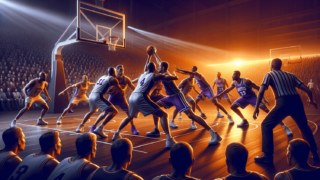
Over-and-Back Violation in Basketball: Rules and Examples
Written by: Basketball Universe
Last updated:

If you’ve ever found yourself watching a basketball game and suddenly wondering, “Wait, did they just break a rule?” then you, our curious hoops aficionado, are in the right place! In this riveting blog post, we’ll dive into the thrilling world of over-and-back violations—those mysterious moments when a player’s two-step dance with the half-court line turns into a crumbling tango. Sit back, get comfortable, and let this exhilarating journey through the ins and outs of over-and-back violations in basketball teach you everything you’ve ever wanted to know about this topic, complete with rules and enlightening examples.
Over-and-Back Violation in Basketball: Rules and Examples
An over-and-back violation occurs when a team with possession of the ball crosses the half-court line into their frontcourt and then sends the ball back into their backcourt. This action results in a loss of possession and the opposing team gains the ball. Exceptions to this rule include instances when the ball is knocked or deflected by the defense, and when a player with both feet and the ball in the frontcourt jumps, but releases the ball before landing in the backcourt.
Understanding the Basics of Over-and-Back Violations
To truly appreciate the intricacies of over-and-back violations, we must begin by understanding the basics. When a team gains possession, they have a certain amount of time to advance the ball past the half-court line—usually 8-10 seconds, depending on the league—and into their frontcourt. Once the ball has crossed the half-court line, the team is no longer allowed to send the ball back into their backcourt. Doing so results in an over-and-back violation.
Why Do Basketball Rules Include Over-and-Back Violations?
Over-and-back violations are in place to maintain the flow of the game and prevent teams from wasting time or playing a stall game. Without this rule, teams with the lead could simply move the ball back and forth between the frontcourt and backcourt to drain the clock and deny the opposing team any opportunities for scoring. Such actions would make for a dull and tedious game, which wouldn’t be enticing for the players or the audience!
Key Aspects of the Over-and-Back Rule
Establishing Frontcourt Position
When it comes to determining if an over-and-back violation has occurred, the primary factor to consider is whether the ball and the player have fully established their position in the frontcourt. For this to have taken place, the player must have both feet touching the frontcourt, and the ball must be touching the frontcourt as well.
Understanding Exceptions
Of course, as with most basketball rules, there are some exceptions when it comes to over-and-back violations. These include:
- Deflections and loose balls: If a defensive player touches the ball or causes the ball to enter the backcourt, it is not considered an over-and-back violation.
- Airborne players: If a player with the ball in the frontcourt jumps to avoid a defender and lands in the backcourt, but releases the ball before landing, no violation occurs.
- Allowance for momentum: If a player secures a loose ball near the half-court line and their momentum carries them into the backcourt, there is no violation so long as they didn’t have both feet and the ball in the frontcourt before crossing over.
Examples of Over-and-Back Violations in Action
Diving into real-world examples will provide a clearer understanding of how over-and-back violations can occur on the court.
Example 1: Miscommunication Between Teammates
Consider a scenario in which a point guard has just crossed the half-court line with the ball, establishing their frontcourt position. However, their teammate, still in the backcourt, does not anticipate the pass, causing the ball to sail back over the line, untouched. In this case, an over-and-back violation would be called as the offense threw the ball back into their own backcourt.
Example 2: The Pressure Defense Tactic
In another example, a defensive team uses a full-court press to apply pressure on the ball handler. The offensive player, while in the frontcourt, panics and attempts a cross-court pass. Unfortunately, the ball sails too high and over the half-court line. This scenario, too, results in an over-and-back violation, and the ball gets awarded to the defensive team.
Example 3: When No Violation Occurs
To understand when an over-and-back call wouldn’t be made, picture a situation where a point guard dribbles the ball past the half-court line and encounters defensive pressure. However, the defensive player manages to deflect the ball out of the point guard’s control and back into the backcourt. In this instance, no violation occurs because the defense caused the ball to cross the line.
Common Misconceptions and Misinterpretations
To avoid confusion, it’s essential to clear up some common misconceptions and misinterpretations surrounding over-and-back violations in basketball.
Misconception 1: Stepping On or Over the Half-Court Line
Many people believe that stepping on or over the half-court line while in possession of the ball results in an over-and-back violation. However, this is not the case. The violation occurs when the ball and the player have fully crossed the half-court line and then been sent back into the backcourt. Simply touching the line or stepping over it momentarily does not result in a violation.
Misconception 2: Failure to Advance Past Half-Court Within the Time Limit
Another common misunderstanding involves mixing up the over-and-back violation with the 8 or 10-second rule (also known as the backcourt violation), depending on the league. The latter occurs when a team fails to advance the ball past the half-court line within the specified time limit. While both violations result in the loss of possession, these are distinct rules and should not be confused.
Mastering Over-and-Back Violations: Tips and Strategies
Utilizing Defensive Pressure to Force Violations
Defensive players can utilize pressure tactics to force over-and-back violations. By applying full-court pressure, defenses can create confusion and chaos for the offense, increasing the likelihood of ball handlers committing errors. Communication and proper positioning are critical in these defensive strategies.
Offensive Strategies to Avoid Violations
Offensive players can take certain steps to minimize the risk of over-and-back violations. These include:
- Utilizing good passing techniques to ensure accurate passes between teammates.
- Maintaining court awareness and understanding teammates’ positions before making a pass.
- Adopting effective dribbling skills in high-pressure situations.
- Developing strong communication between teammates to prevent miscommunication on the court.
By mastering these skills, players can minimize the chances of over-and-back violations, maintain possession, and improve their team’s overall performance on the court.
Beyond Over-and-Back: Common Court Violations to Be Aware Of
Now that you’re an expert in the over-and-back violation, it might be helpful to familiarize yourself with other common court violations in basketball to enhance your overall understanding of the game. Being aware of these rules can not only give you a well-rounded knowledge of basketball but also help you appreciate its strategic components.
Backcourt Violation (8- or 10-Second Rule)
As mentioned earlier, the backcourt violation, also known as the 8- or 10-second rule, occurs when the offensive team fails to bring the ball past the half-court line within the allotted time. The timer resets if the ball is deflected or touched by a defensive player. If the offensive team fails to advance the ball within the specified time limit, possession goes to the opposing team.
Traveling Violation
Traveling, a widespread violation in basketball, occurs when a player moves one or both of their feet illegally while they have possession of the ball. Typically, the player is allowed to take two steps after receiving the ball or finishing a dribble. When colliding with a defender, if the offensive player loses their connection to the ball, performing a subsequent dribble is not considered traveling.
Double Dribble Violation
A double dribble violation takes place when a player dribbles the ball with both hands or starts dribbling again after picking it up. Once a player picks up the ball, they must either pass or shoot; restarting a dribble is not allowed. The opposing team gains possession of the ball when a double dribble violation occurs.
Three-Second Violation
A three-second violation is called when an offensive player remains inside the key (or the free-throw lane) for three consecutive seconds without actively attempting a shot. This rule exists to prevent taller players from remaining near the basket and dominating play. If a three-second violation is called, the opposing team receives the ball.
Five-Second Violation
There are two types of five-second violations:
- Inbounding: If a player fails to inbound the ball within five seconds after stepping out of bounds, the opposing team gains possession.
- Closely guarded: When a player with the ball is guarded by an opponent within six feet, they must pass or shoot within five seconds. Failure to do so results in a violation, and the opposing team takes possession of the ball.
By expanding your knowledge on over-and-back violations and these additional common court violations, you’ll be able to appreciate the nuances of the game and the strategic maneuvers that both offense and defense implement during a match. Keep sharpening your understanding of basketball rules and regulations, and you’ll soon become the ultimate basketball connoisseur!
Frequently Asked Questions: Over-and-Back Violation and Related Rules
For a quick and easy overview of over-and-back violations and other relevant basketball rules, we’ve compiled a list of frequently asked questions. This FAQ section is designed to address common queries and offer concise explanations so you can quickly find the information you’re looking for.
1. What is an over-and-back violation in basketball?
An over-and-back violation occurs when a team with possession of the ball crosses the half-court line into their frontcourt and then sends the ball back into their backcourt. This results in a loss of possession, and the opposing team gains the ball.
2. What happens if a defensive player touches the ball before it enters the backcourt?
If a defensive player touches the ball or causes it to enter the backcourt, it is not considered an over-and-back violation. In this case, the offensive team can recover the ball without penalty.
3. Does stepping on the half-court line constitute an over-and-back violation?
Simply stepping on or over the half-court line does not result in an over-and-back violation. The violation occurs when the ball and the player have fully crossed the half-court line and then been sent back into the backcourt.
4. How are over-and-back violations different from backcourt violations?
An over-and-back violation occurs when a team sends the ball back into their backcourt after establishing their frontcourt position. In contrast, a backcourt violation (the 8- or 10-second rule) takes place when a team fails to advance the ball past the half-court line within the specified time limit.
5. What is a traveling violation?
Traveling is a violation that occurs when a player moves one or both of their feet illegally while holding the ball. Typically, a player is allowed to take two steps after receiving the ball or finishing a dribble. Traveling results in a loss of possession for the offending team.
6. What is a double dribble violation?
A double dribble violation occurs when a player dribbles the ball with both hands or starts dribbling again after picking up the ball. Once a player stops dribbling, they must either pass or shoot. The opposing team gains possession when a double dribble violation occurs.
7. What is a three-second violation?
A three-second violation is called when an offensive player remains inside the key (or the free-throw lane) for three consecutive seconds without actively attempting a shot. This rule prevents taller players from dominating play near the basket. The opposing team receives the ball following a three-second violation.
8. What is a five-second violation in basketball?
There are two types of five-second violations: inbounding and closely guarded. Inbounding occurs when a player fails to inbound the ball within five seconds, whereas the closely guarded violation takes place when a player with the ball is guarded by an opponent within six feet and does not pass or shoot within five seconds. Both violations result in the opposing team gaining possession.
9. How do defensive strategies affect the likelihood of over-and-back violations?
Defensive players can use full-court pressure to create confusion and chaos for the offense, increasing the chances of ball handlers committing over-and-back violations. Proper communication and positioning on the court are essential for these defensive tactics to be effective.
10. Can a player avoid an over-and-back violation when jumping from the frontcourt to the backcourt?
If a player in the frontcourt jumps with both feet and the ball but releases the ball before landing in the backcourt, no over-and-back violation occurs. However, if they land in the backcourt with the ball still in their possession, a violation will be called.
Featured Posts
- No pillar pages found.





